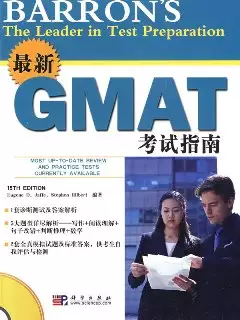Graduate student pos的問題,透過圖書和論文來找解法和答案更準確安心。 我們找到下列股價、配息、目標價等股票新聞資訊
Graduate student pos的問題,我們搜遍了碩博士論文和台灣出版的書籍,推薦EugeneD.JaffeandStephenHibert寫的 最新GMAT考試指南(附贈CD-ROM) 可以從中找到所需的評價。
國立彰化師範大學 人力資源管理研究所 蔡啟通所指導 許美青的 完美主義、主動拖延及工作績效之關係:以知覺組織支持為調節變項 (2020),提出Graduate student pos關鍵因素是什麼,來自於完美主義、主動拖延、知覺組織支持、工作績效。
而第二篇論文南華大學 企業管理學系管理科學碩博士班 吳萬益、紀信光所指導 阮慶雲的 探討領導風格和組織支持對員工心理資本和工作績效的影響 (2019),提出因為有 心理資本、領導風格、組織支持、工作成果、績效的重點而找出了 Graduate student pos的解答。
最新GMAT考試指南(附贈CD-ROM)

為了解決Graduate student pos 的問題,作者EugeneD.JaffeandStephenHibert 這樣論述:
國際知名教本全美商學院攻略北美權威專家精心打造最新GMAT機考詳盡介紹應試策略與答題技巧一網打盡 1套診斷測試及答案解析; 5大題型詳盡解析——寫作+閱讀理解+句子改錯+判斷推理+數學; 2套全真模擬試題及標准答案,供考生自我評估與檢測。 Barron’s Graduate Management Admission Test (GMAT) is designed to assist students planning to take the official Graduate Management Admission Test governed
by the Graduate Manage-ment Admission Council, headquartered in Virginia,and administered by Pearson VIDE,an elec-tronic testing company operating more than 5,000 computer centers in over 145 countries. Since the results of the GMAT are used by many graduate schools of business as a means for measur
ing the qualifications of their applicants,it is important that the prospective student do as well as pos-sible on this exam. Admission to business school may well depend on it. A study guide,although not able to guarantee a perfect score, can provide a good deal of assis-tance in test preparatio
n by enabling students ’to become familiar with the material they will encounter on the exam and supplying them with ample opportunity for practice and review. With this in mind,we have developed a study guide that goes further than the simple simulation of the official GMAT in its effort to offer a
sound basis of test preparation. Besides containing three prac-tice tests with questions(and answers)similar to those students will encounter on the actual exam,it offers invaluable advice on how to prepare for the exam, ranging from a general discussion of the purpose and various formats of the GM
AT to a step-by-step program of subject analysis and review designed to help students discover their weak points and take measures to correct them. A tactics section is included that covers every question type. These tactics give students practical instructions and hints on how to analyze and answer
each question.
完美主義、主動拖延及工作績效之關係:以知覺組織支持為調節變項
為了解決Graduate student pos 的問題,作者許美青 這樣論述:
「拖延」真的是一件不好的行為嗎?本研究以拖延的正向功能進行探討,根據自我效能理論,希望能瞭解以一般產業界員工來說,會受什麼樣的因素影響而決定採取主動拖延行為,以及主動拖延會如何影響其工作表現。此外,提出知覺組織支持為調節變項,以了解相對關係之調節效果。本研究採便利抽樣發放主管與部屬配對問卷,結果顯示:(1)表現與期望落差與主動拖延有負向關係、高標準與主動拖延有正向關係;(2)主動拖延與工作績效有正向關係;(3)主動拖延對表現與期望落差跟工作績效有中介效果影響、主動拖延對高標準與工作績效有中介效果影響(4)知覺組織支持會調節主動拖延與工作績效之正向關係,相較於高知覺組織支持,低知覺組織支持會強
化主動拖延與工作績效之正向關係。本研究貢獻有以下幾點:在學術上,驗證了表現與期望落差、高標準會透過主動拖延的中介而影響工作績效,同時發現知覺組織支持會調節主動拖延與工作績效之關係;在實務上,透過學術上驗證的結果,將完美主義納為人資實務管理之意涵,對於主動拖延類型員工建議應採彈性化管理,而非緊迫盯人軍事化管理。
探討領導風格和組織支持對員工心理資本和工作績效的影響
為了解決Graduate student pos 的問題,作者阮慶雲 這樣論述:
LETTER OF RECOMMENDATION i中文摘要: iiABSTRACT iiiTABLE OF CONTENTS vLIST OF TABLES viiiLIST OF FIGURES ixCHAPTER ONE INTRODUCTION 11.1 Research Background and Motivation 11.2 Research Objectives 51.3 Research Contribution 61.4 Research Project and Scope of the Study 61.5 Research Procedure
71.6 The Structure of the Study 9CHAPTER TWO LITERATURE REVIEW 102.1 Social Exchange Theory (SET) 102.2 Psychological Capital (PsyCap) 122.3 Antecedents of Psychological Capital: 142.3.1 Authentic Leadership 142.3.2 Ethical Leadership 152.3.3 Abusive Leadership 172.3.4 Organizational Support
182.4 Consequences of Psychological Capital 192.4.1 Desirable Outcomes 192.4.1.1 Job Satisfaction 192.4.1.2. Organizational Commitment 212.4.1.3 Organizational Citizenship Behavior (OCB) 222.4.2 Undesirable Outcomes 242.4.2.1 Cynicism 242.4.2.2 Deviant Behaviors 252.4.2.3 Workplace Incivili
ty 262.4.2.4 Turnover Intention 272.4.3 Employee Performance 272.4.4. Inter-relationship Among Antecedents and Consequences of PsyCap 282.4.4.1 The Relationship Between Leadership Styles, Perceived Organizational Support, and Subordinate’s PsyCap 282.4.4.2 The Relationship Between Psycap and Wo
rk Outcomes 312.4.4.3 The Relationship Between PsyCap and Employee Performance 322.4.4.4 The Relationship Between Leadership Styles and Work Outcomes 332.4.4.5 The Relationship Between Organizational Support and Work outcomes 352.4.4.6 The Relationship Between Leadership styles, POS, and Employe
e Performance 372.4.4.7 The Relationship Between Work Outcomes and Employee Performance 382.4.4.8 The Mediator Effect of PsyCap 402.4.4.9 The Potential Moderator Effect of Subordinate’s Characteristics 41CHAPTER THREE RESEARCH DESIGN AND METHODOLOGY 443.1 Study One: Meta-analysis 443.1.1 Meta-a
nalytic Procedure 443.1.2 Sample Plan 463.1.3. Data Analysis Techniques 463.2. Study Two: Survey 493.2.1 Research Hypotheses 493.2.2 Research Instruments 523.2.2.1 The Antecedents of PsyCap 523.2.2.2 The Consequences of PsyCap 523.2.2.3 PsyCap and Task Performance 533.2.3. Questionnaire Des
ign 533.2.4. Sampling Plan 543.2.5 Data Analysis Techniques 553.2.5.1. Descriptive Statistic Analysis 553.2.5.2 Reliability and Validity Measures (Evaluation of Measurement Model) 553.2.5.3. Hypotheses Testing Techniques (Evaluation of Structural Model) 563.2.5.4. Evaluation of Mediating Effec
ts and Moderating Effects 57CHAPTER FOUR EMPIRICAL RESULTS AND DISCUSSIONS 594.1 Meta-analysis Results 594.1.1 Descriptive Analysis of Collected Data 594.1.2 Inclusion Criteria and Coding 594.1.3 Mediating Effects and Moderating Effects 664.1.4 Results 664.1.4.1 Results of Main Effects 664.1.
4.2 Results of Mediator Effects 724.1.4.3 Results of Moderator Effects 754.1.5 Discussions 774.2. Questionnaire Survey Results 804.2.1 Characteristics of Respondents 804.2.2 Measurement results for Research Variables 814.2.3 Evaluation of the Measurement Model 854.2.4 Evaluation of the Struct
ural Model 894.2.4.1 Evaluation of the Direct Effects 894.2.4.2 Evaluation of the mediator effects 964.2.4.3 Evaluation of the moderating effects 100CHAPTER FIVE CONCLUSIONS AND SUGGESTIONS 1035.1 Conclusions 1035.1.1 Theoretical Implications 1035.1.2. Managerial Implications 1085.3 Limitati
ons and Future Research Directions 112REFERENCE 115APPENDIX 157LIST OF TABLESTable 1.1 The Scope of This Study 6Table 4.1 The Studies Included in The Meta-Analysis 61Table 4.2 Meta-analytic Relationship about the Antecedents and Consequences of PsyCap 67Table 4.3 Meta-analytic Relationship abo
ut the Leadership and Work Outcomes 69Table 4.4 Meta-analytic Relationship about the Leadership, POS, Work Outcomes & Performance 70Table 4.5 Meta-analytic results for the Mediator Effects of PsyCap 73Table 4.6 Meta-analysis Results of Moderator Effects 76Table 4.7 Characteristic of Respondents
in This Study (n=418) 80Table 4.8 Descriptive Analysis for Questionnaire Items 81Table 4.9 Reliability Test and Internal Consistency 86Table 4.10 Fornell-Larcker Criterion 88Table 4.11 The Heterotrait-Monotrait Ratio (HTMT) 89Table 4.12 Evaluation of Structural Model (H1 to H3) 90Table 4.13 Eva
luation of Structural Model (H4a-H4b) 91Table 4.14 Evaluation of Structural Model (H5a to H8b) 93Table 4.15 Assessment of Predictive Relevance of Path Model 95Table 4.16 The Evaluation of Mediating Effects of PsyCap (H9a-H9b) 98Table 4.17 The Evaluation of Mediating Effects of PsyCap (H10a to H1
1b) 99Table 4.18 The Results of the Moderating Effect of Gender, Age, Tenure 101LIST OF FIGURESFigure 1.1 The flow chart of this research 8Figure 3.1 The conceptual framework of this research 51